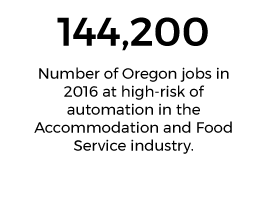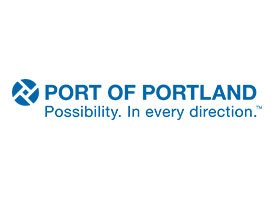Oregon’s Story
The distribution of these risk predictions makes some intuitive sense. Most transportation occupations fall in the high-risk category — unsurprising given the recent attention and investment in autonomous vehicles. Sales work, also at high-risk, has seen recent losses as brick-and-mortar retailers give way to online shopping. On the other end of the scale, the low-risk occupations consist of tasks that humans are uniquely able to do: Persuasion and negotiation in legal matters; compassion and caring in health care; creativity and originality in engineering and design.
The Oxford risk-of-automation analysis plays out differently across states and regions within states. Applying the Oxford findings to Oregon’s mix of occupations yields a number of important insights.
Oregon’s overall risk of automation is similar to that of the nation’s. However, the mix of occupations that get us to that average differs. Oregon has a typical share of workers employed in occupations with the highest risk of automation. Our concentrations of easier-to-automate jobs — sales, office and administrative support, food preparation and transportation — are similar to those in other states; but for low-risk automation occupations, Oregon differs from the U.S. in offsetting ways. Though Oregon has higher concentrations of architects, engineers, business managers, life and physical scientists, personal care providers, and community and social-service workers, we have lower than typical concentrations of other hard-to-automate jobs like teachers, police, firefighters, health care professionals and lawyers.
Automation is a bigger threat to occupations that pay low and middle wages. Exceptions include health care support, building and ground maintenance, and installation and repair work that are at the lower ends of both the wage and risk scales. How to address low-wage, non-routine work that is at risk of automation and the likely changes that will occur will be central to Oregon’s policy debates going forward. See Figure 2.
Accommodation and food service, retail trade and manufacturing have sizable numbers of employees at risk. The finding for manufacturing is unsurprising because technology for years has already allowed the industry to produce more output with fewer workers. The future of food service, accommodation and retail trade jobs are a little more speculative. Those occupations blend routine work with social interaction skills, which means occupations could shift emphasis rather than disappear entirely. See Figure 3.
Oregon’s rural counties, specifically the coastal region, are at higher risk of automation. Portland, Corvallis and other metropolitan areas have a lower risk. Rural regions have low concentrations of jobs that are hard to automate (e.g., business managers, engineers, architects, lawyers, artists and designers) and higher concentrations of occupations that lend themselves to automation (e.g., transportation). Bright spots for rural Oregon are community and social service workers, personal care providers, health care workers and scientists (e.g., foresters, soil and plant scientists, agricultural and food scientists). Meanwhile, Oregon’s metro areas — especially Portland and Corvallis — benefit from a range of professional and business service work that, for the time being, is outside the grasp of technology. See Figure 4.
The decline in workforce participation has played out differently by level of educational attainment. Nationally, only 6 percent of prime-age males (ages 25-54) holding a bachelor’s degree or more are outside the labor force; but for those with a high school diploma or less, non-participation has risen to 17 percent. Few statistics make a better case about the need to boost the education and skills of the American workforce. The disruption of work from technology is not a futuristic concern. In Oregon, 13 percent of prime-age males were not working in 2016. See Figure 5.
The bottom line: Future disruption of technology appears pointed at low- and middle-wage workers and rural communities that are already struggling; it will also disproportionately impact prime-age males. While no one expects half of jobs in the Portland area or 60 percent of jobs along the coast to disappear overnight, even a continued drift in this direction poses significant challenges.
The absence of work — or even the pursuit of it — is a harsh reality for many in Oregon and across the nation. A dynamic economy has left too many people behind, and growing frustrations and fears are reflected in an unstable political environment. Improving conditions for people hit hardest by automation and globalization will be critical to return to a more stable and broadly prosperous era.
Oregon is well served in many respects by being on the frontier of these matters with innovative companies and organizations defining this new future. Oregon should seize business opportunities that come with the expected onslaught of disruptive technologies. However, for Oregonians to be able to broadly share in future prosperity, it is critical that the state and region redouble their efforts to boost the skills of workers who will face the ever more complex future of work.

The case of Techno-Optimists

The case of Techno-Pessimists

Companies Automating in Oregon

What it All Means











